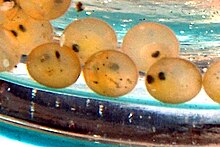Lake trout
When lake trout is a living in large, oxygen-rich lakes large-growing form of trout ( Salmo trutta called). Although described under the name Salmo trutta lacustris ( Linnaeus , 1758), the lake trout is not a subspecies of the trout, but rather large populations that are not more closely related to each other than to the brown trout in the running waters, which are their home surround. Lake trout are found in Central Europe, the Alpine region , Scandinavia , the Baltic States , northern Russia, the British Isles and Iceland .
features
Lake trout reach lengths of 40 to 80 cm. Your body is elongated, slightly flattened on the sides and has a different color depending on the living area. The mostly very light flanks are always patterned with irregular blackish, occasionally also brown or reddish points or rings. The scales are small, 110 to 120 are counted along the lateral line , 14 to 19 between the lateral line and the adipose fin . The muzzle ends bluntly, the crack in the mouth extends behind the eyes. Of the gill trap rays of the first gill arch, the upper and lower ones are button-shaped, the middle ones rod-shaped. The ploughshare is toothed, there are 4 to 6 teeth on the plate, on the handle there is a single row of teeth at the front and a double row at the back. The teeth on the stalk of the plowshare are bent alternately to the right or left. Older lake trout are higher back than young ones.
Way of life
Lake trout are migratory fish that rise up in the tributaries of their living waters to spawn and only spawn occasionally in the lakes themselves. In the third to fourth year of life, the spawning lake trout from a size of around 50 cm rise into the upper reaches of the tributaries. Their migration usually takes place in the dark. They spawn from September to December. The Rogner (female) looks for a suitable place for his spawning pit, which is largely dependent on the flow speed, the water depth and the substrate composition. He usually finds it at the outlet of a scour on loose, gravelly substrate. Once the female has found a place, it begins to cut a spawning pit up to 40 cm deep. The Milchner (male) defends the female from other male competitors. A female then lays 1000 to 2000 eggs per kilogram of body mass in spawning pits in the gravel bottom. The eggs are 5 to 5.5 mm in diameter. The male fertilizes the eggs at the same time as his semen. Other fish, especially brown trout and smaller lake trout, try to participate in the spawning business or to eat the eggs. After the egg-laying is complete, the Rogner covers the spawning pit with the surrounding substrate and watches over it for some time. The hatched fry migrate back to the lakes in the first or second year of life. The maximum age is around 10 years.
Lake trout feed on small animals, larger adults, called “ground trout”, also feed on fish. Because of the large proportion of crustaceans in their diet, the meat of the lake trout is rosy, and it is sold in the trade (like other salmonids with reddish meat) as salmon trout .
literature
- Uwe Hartmann: freshwater fish. Recognize & determine (= Steinbach's natural guide ). 2nd, unchanged edition. Ulmer, Stuttgart 2003, ISBN 3-8001-4296-1 .

